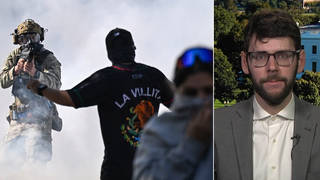
Topics
Guests
- Glenn Greenwaldattorney and blogger at Salon.com. His recent posts include “Vital Unresolved Anthrax Questions and ABC News”, “Additional Key Facts Re: The Anthrax Investigation” and “Journalists, Their Lying Sources, and the Anthrax Investigation”
- Dr. Meryl Nassexpert on anthrax and editor of the blog AnthraxVaccine.blogspot.com
The FBI’s prime suspect in the October 2001 anthrax letters case died last week in an apparent suicide. Bruce Ivins was an elite government scientist at the biodefense research lab in Fort Detrick, Maryland. He was among the nation’s top experts on the military use of anthrax. But many of his colleagues have expressed deep skepticism over the FBI’s claims. We speak to anthrax expert Dr. Meryl Nass and blogger Glenn Greenwald. [includes rush transcript]
Transcript
AMY GOODMAN: The FBI’s prime suspect in the October 2001 anthrax letters case died last week in an apparent suicide. Bruce Ivins was an elite government scientist at the biodefense research lab at Fort Detrick, Maryland. He was among the nation’s top experts on the military use of anthrax.
Ivins reportedly died soon after learning the Justice Department was about to file criminal charges against him for the 2001 anthrax attacks that killed five people and sickened seventeen others, crippling the national mail service. He had been part of a team that helped the government investigate the attacks and won the Pentagon’s highest civilian award in 2003.
Many of his colleagues are convinced Ivins was innocent and claim he lacked the motive and the means to develop the fine powder used in the letter scare. They’re also skeptical of the FBI’s investigation, one of the largest in US history, given its false starts over the past seven years. The investigation initially focused on Steven Hatfill, the onetime colleague of Bruce Ivins. But this June, the Justice Department settled with Hatfill for $5.82 million.
Whether Ivins was guilty or not, the case also raises key questions about how the anthrax scare was initially linked to Islamic terrorists and Iraq. In a piece for Salon.com, attorney and author Glenn Greenwald writes repeated claims by the mainstream media linking the attacks to Saddam Hussein helped shape American perceptions about Iraq in the lead-up to the invasion.
Glenn Greenwald joins us now by telephone from Brazil. We’re also joined on the phone by Dr. Meryl Nass. She’s in Maine. She’s an expert on anthrax and knew Bruce Ivins. On her blog, anthraxvaccine.blogspot.com, she writes she believes Ivins was probably innocent.
We welcome you both to Democracy Now! Glenn Greenwald, let’s begin with you. When you heard about Bruce Ivins being the key suspect, about to be indicted, apparently — we all learned this after his suicide — can you talk about your reaction?
GLENN GREENWALD: It’s hard to have any reaction to anything that the government and the FBI say about the anthrax investigation other than extreme skepticism. In light of the fact that everything that they’ve done and said over the past seven years, by all accounts, has been either completely inept or, worse, deliberately misguided away from the true source of the anthrax. And so, all of these news accounts over the past several days that have suggested that Bruce Ivins is the person behind the anthrax attacks are lacking one critical ingredient, and that’s any evidence whatsoever that those claims are true.
And the one thing that I would underscore is, as you said in your introductory remarks, the L.A. Times, when they reported this story originally, said that Ivins was about to be indicted, trying to suggest that it was literally imminent, like a day or two away. And yet, a New York Times story this morning spoke with various investigators at the FBI who have now backtracked significantly on that claim, and they’re saying that all of the evidence that they have against Ivins is, quote, “entirely circumstantial” and that the grand jury intended to hear evidence for at least several more weeks before deciding whether or not to indict him. So there’s all sorts of really mystifying questions that have plagued this case from the start, and there’s even more now, in light of this recent event, and what we need is a real public hearing of all these facts.
AMY GOODMAN: I want to turn to Senator McCain and his comments soon after September 11th. He was on the David Letterman show. It was October 18, 2001. And he brought up Iraq as a possible, quote, “second phase” of the war in Afghanistan. He said the anthrax may have come from Iraq.
DAVID LETTERMAN: How are things going in Afghanistan now?
SEN. JOHN McCAIN: I think we’re doing fine. I think we’ve removed what little anti-aircraft capability they have. These C-130 gunships are pretty awesome weapons of war, and I believe that the Taliban will be removed. I think we’ll do fine. The second phase — if I could just make one very quickly — the second phase is Iraq. There is some indication, and I don’t have the conclusions, but some of this anthrax may — and I emphasize “may” — have come in from — come from Iraq.
DAVID LETTERMAN: Oh, is that right?
SEN. JOHN McCAIN: If that may be the case, then that’s when some tough decisions are going to have to be made.
AMY GOODMAN: President Bush would echo what John McCain had to say, linking Iraq to anthrax in his 2002 State of the Union address just a few months later. This is an excerpt.
PRESIDENT GEORGE W. BUSH: Iraq continues to flaunt its hostility toward America and to support terror. The Iraqi regime has plotted to develop anthrax and nerve gas and nuclear weapons for over a decade. This is a regime that has already used poison gas to murder thousands of its own citizens, leaving the bodies of mothers huddled over their dead children. This is a regime that agreed to international inspections, then kicked out the inspectors. This is a regime that has something to hide from the civilized world.
AMY GOODMAN: That was President Bush in 2002. And now, the New York Daily News is reporting in the immediate aftermath of the 2001 anthrax attacks, White House officials repeatedly pressed FBI Director Robert Mueller to prove it was a second-wave assault by al-Qaeda. So, Glenn Greenwald, take us from the point of the attacks to the direction the investigation took, from the government and this information to Steven Hatfill.
GLENN GREENWALD: Well, clearly, the focus in the initial phases was on trying to link the anthrax attacks to Islamic terrorism and as a second stage of the 9/11 attacks. And in fact, the anthrax attacker or attackers clearly had the same goal in mind. I mean, the letters that accompanied the anthrax, a lot of people have forgotten, were dated 9/11/01, and they said things like, “We have anthrax. Prepare to die. Death to America. Death to Israel. Allah is great.” And so, there was a clear attempt on the part of the attackers themselves to link the attack to Islamic radicalism.
And then all sorts of sources inside of the government were claiming that there was evidence found at the Fort Detrick lab, where the government now says the attacks came from, that also linked the attacks to Iraq. There was one particularly influential story from ABC News and Brian Ross, where for days and days, on Peter Jennings and other shows, they claimed that they were told by many sources inside the government that tests had found the presence of something called bentonite, which is the hallmark, they said, of the Iraqi biological weapons program. It turned out that claim was totally false. There never was any bentonite found in the anthrax, everybody now agrees, and yet, as you showed from the clip from John McCain — there was clips from Joe Lieberman several days later on Meet the Press —- there was a concerted effort to try and link the anthrax in the public mind to Saddam Hussein and to Iraq, specifically, and Islamic radicalism, more generally.
The FBI ultimately, through their tests, decided that all of the evidence was actually pointing to US government facilities and US government and US Army research labs, of the type where Bruce Ivins and Steven Hatfill worked at Fort Detrick. And so, they were aware from the start that it was almost certainly a domestic source, and yet all kinds of factions, within the government and out, tried continuously to depict it as something that was likely coming from Iraq, and they continued to do that for several years, even when it was clearly established that it was almost certainly a domestic source.
AMY GOODMAN: We’re going to go to a break. When we come back, we’ll also be joined by Dr. Meryl Nass, who is an anthrax expert, physician and writer, blogs at anthraxvaccine.blogspot.com and knew Bruce Ivins, the man who committed suicide last week. This is Democracy Now!, democracynow.org, the War and Peace Report. Back in a minute.
[break]
AMY GOODMAN: We continue our discussion in this aftermath of the apparent suicide of Bruce Ivins, the man who now the government says was moving in on perhaps to indict holding him responsible for the anthrax attacks of 2001. He committed suicide right after being informed that he was the prime suspect in the investigation. Our guests are Glenn Greenwald, constitutional law attorney and blogger for Salon.com, his latest book is Great American Hypocrites: Toppling the Big Myths of Republican Politics; and Dr. Meryl Nass joins us now from Maine, who blogs at anthraxvaccine.blogspot.com.
Did you know Bruce Ivins, Dr. Nass? Dr. Nass?
DR. MERYL NASS: Yes. [inaudible]
AMY GOODMAN: Did you know Bruce Ivins?
DR. MERYL NASS: Yes, I knew him.
AMY GOODMAN: Tell us about who he was.
DR. MERYL NASS: He was a very pleasant, sort of Midwestern scientist, salt of the earth kind of guy, maybe a little bit nervous. He did good work. I was able to rely on the quality of his work in all the many papers that he published on anthrax vaccine. And he was a generous scientist, in that he was always willing to discuss work that I was doing and provide me with papers or information about that work.
AMY GOODMAN: Were you surprised when you heard the government was targeting him?
DR. MERYL NASS: Yes, I was completely shocked. And of course, I found that out after he had committed suicide. He would be the last person I would have suspected, not that I’m any expert, but I have been told that there is no forensic personality for a crime like this that’s been defined. So, I guess it’s possible that he did it, but I absolutely cannot come up with a motive, with access and with the complicated things that would need to be done if he were a loner performing such an act.
And I am struck by the fact that there were at least two earlier people who, in my view, appeared to have been set up as possible patsies for the letter attacks, and Hatfill being one and Ayaad Assaad being another. The week the letters were sent, a letter was sent to Quantico implicating Assaad. And the Quantico letter actually arrived before the anthrax letters, but it seemed that there was a definite intent to link Assaad. So -—
AMY GOODMAN: Explain who Assaad was.
DR. MERYL NASS: Assaad was an Egyptian scientist who previously had worked at Fort Detrick. He was not an anthrax scientist; neither was Hatfill. And he had had a difficult time at Fort Detrick. There were a number of other scientists who used to make fun of him. Laura Rozen outlined all this in an article in Salon.com back about five or six years ago. As a result, he left. He filed a — I think an age discrimination suit against Fort Detrick. And he was called in for questioning after this letter appeared. So it looked like somebody was trying to finger Assaad.
And then, later, there were a lot of odd coincidences with respect to Steven Hatfill and his travels and his past history and living in Rhodesia that had correspondence with features of the anthrax attacks. So he had lived in Harari, which had a suburb named Greendale, and there were these letters post-marked Greendale — not post-marked, but Greendale was the return address. So there were — it seemed that somebody who knew a bit about Hatfill’s life also had attempted to implicate him in the letters.
So now we have Ivins. And the Defense Department — sorry, not the Defense, Justice Department has failed to provide to the public any shred of evidence that really would link Ivins in any kind of definitive way to this crime. This morning, we’re being told that there is forensic scientific evidence to show that the strain in the letters was a strain that came from his lab. But, you know, the old saw in bioterrorism is that of course you select your agent from — so that it will make somebody else look guilty. So, somebody else could have gotten a strain from his lab in order to cast aspersions on Ivins. The fact that it was found in his lab really means nothing. I mean, a smart scientist who is going to create an attack like this is clearly not going to choose anthrax that’s going to lead right back to his own lab. So I think that no matter how fancy the forensics gets, you’re not going to get an answer there. And if that is the basis for the charges against Ivins, it is, in my mind, very weak.
AMY GOODMAN: I wanted to go back to an interview that I did in July of 2003 with Patrick Clawson, the friend and former spokesperson for Steven Hatfill. I asked Clawson about the FBI investigation that named Hatfill as a, quote, “person of interest” in the anthrax case.
PATRICK CLAWSON: The problem that Steve Hatfill has is that his life is a living nightmare right now. Every place he goes, twenty-four hours a day, seven days a week, he is followed by squads of FBI agents. Just last week, Steve and I went out to have some drinks and dinner, and as soon as I left his house, bam!, I had seven FBI cars following me all over northwest Washington, D.C. Sometimes these agents swear at him, they flip him the finger. There’s nothing surreptitious about this. This is not a surveillance. This is an open, in-your-face harassment campaign. Steve Hatfill is a poster boy for abuses of the PATRIOT Act.
AMY GOODMAN: That was Patrick Clawson, friend of Steven Hatfill, who just a few weeks ago won more than $5.8 million from the US government. Glenn Greenwald, can you talk about that campaign against Steven Hatfill — there was very little attention about the fact he just won $6 million — and then the fingering of Bruce Ivins?
GLENN GREENWALD: Yeah, it’s really extraordinary. I mean, they basically destroyed his life and destroyed his reputation. And what was so amazing about that was that, for years, what they did was, investigators inside the Justice Department and the FBI continuously and systematically leaked to a whole slew of reporters all kinds of accusatory innuendo about Hatfill, information about his medical records, about things that they had found in his garbage cans about parts of his personal life that they had obtained as a result of a very widespread surveillance. And they absolutely tailed him in a way that was designed to make him in public appear as though he was clearly the guilty party.
And then, when it came — when he sued essentially everybody — the government and all of the journalists who had published all of this information — the journalists acted to protect the government in every way. I mean, they refused to disclose who it was who had fed them this information. And the court ultimately ended up ordering the journalists to disclose their sources, so that Hatfill was on the verge of finding out who inside the Justice Department and the FBI had been disclosing all this information designed to make him look like the anthrax attacker, when as the government, ultimately, through its actions, ended up conceding, by paying him millions of dollars and then by ultimately now charging or accusing Ivins of being the attacker. All of this information was untrue all along. And so, the investigation was directed almost exclusively at someone who the government now says had nothing to do with the attacks, and they used the media along the way to publicly convict him and destroy his life. And the media not only cooperated enthusiastically, but continues to protect the people inside the government who did that.
And, of course, you see the same thing with the media doing that with regard to who inside the government tried to lie to the public by connecting the attacks to Iraq. And now, Ivins is essentially being convicted in public, as well, through selective leaks from the government to the media that then prints it more or less uncritically. So the whole investigation has been a sham from the start. And even if you want to be as generous as possible in your interpretation, you would say that it’s been filled from start to finish with pure ineptitude. And that’s why I think a full-scale congressional investigation or the kind of commission that was charged with investigating the 9/11 attack, with real subpoena power, is absolutely vital here to having the public believe that they’ve gotten even the basic facts about what occurred.
AMY GOODMAN: What about the court documents and tapes that reveal his therapist Jean Duley’s concerns to the FBI after receiving death threats from Ivins?
GLENN GREENWALD: Well, I find that whole part of the story bizarre in so many ways. I mean, first of all, if you look at Bruce Ivins’ history, he doesn’t actually have a shred of a criminal record. By contrast, Jean Duley, who is not actually a psychiatrist or a psychologist, she’s actually a social worker who just recently graduated from school and is the kind of social worker who does things like, you know, lead group therapy sessions and the like. She’s hardly a credible or authoritative expert on someone’s psychological state, as she’s been depicted, but she actually has a long history of being involved in various court proceedings. She was convicted in 2007 and then again — in 2006, then again in 2007, of driving under the influence of alcohol. She’s been on probation. She’s still on probation, actually. She’s had significant financial difficulties.
And all of a sudden, out of the blue, while working with the FBI, she starts making some very extreme accusations about Bruce Ivins’ history, about his psychological condition, that none of his co-workers or friends or people who know him confirm in any way, shape or form — in fact, they vehemently contradict it. And so, so much of the media’s depiction of Ivins as this kind of unstable, violent, threatening psychotic is based on the claims of someone who, for a lot of different reasons, really isn’t particularly credible. I mean, it may turn out that Ivins is guilty, it may turn out that what she said is true, but before anyone even forms an opinion about those issues, we ought to wait and see what the evidence really is. And so far, what the media has given us is extremely unconvincing.
AMY GOODMAN: Finally, Dr. Meryl Nass, there has been reports that the investigation will basically be finished by the end of the week, will wrap up, and there will be more information implicating Dr. Ivins.
DR. MERYL NASS: You know, what I’m afraid of, Amy, is that we will hear a lot of fluff and that the investigation will in fact wrap up, and all the important information will be classified. We’ve already gotten a tremendous amount of misinformation from an unidentified government spokesperson, and that is not just this weekend, but going back to the initial release of the letters. There has been a tremendous amount of innuendo and information put forward that has never been backed up and never been attributed to anybody.
And I fear that because a variety of the information that may be used to convict Bruce Ivins after his death is going to be classified, or perhaps we will be given false information, that it will become impossible to defend him and impossible to really make sense of the entire letters case. And I’m very concerned about the whole concept of having significant amount of information in a criminal case that is classified or that only the Justice Department has access to and whether that precludes justice for people who are ensnared in those cases.
AMY GOODMAN: Well, I want to thank you both for joining us, Dr. Meryl Nass, anthrax expert, physician, writer, writes at anthraxvaccine.blogspot.com, and Glenn Greenwald, speaking to us from Brazil, constitutional law attorney, blogger for Salon.com.












Media Options